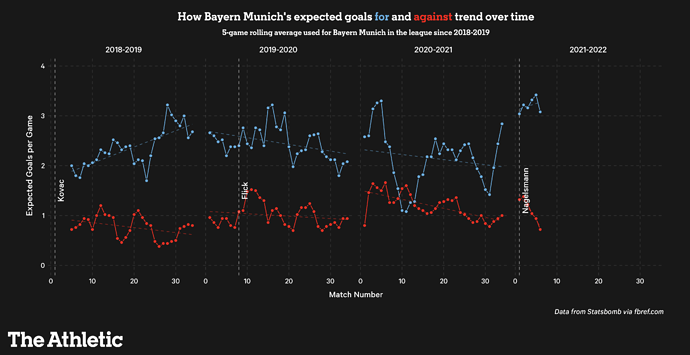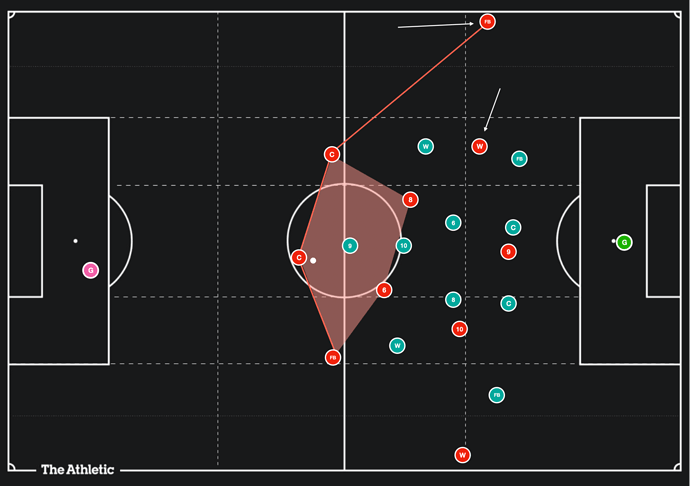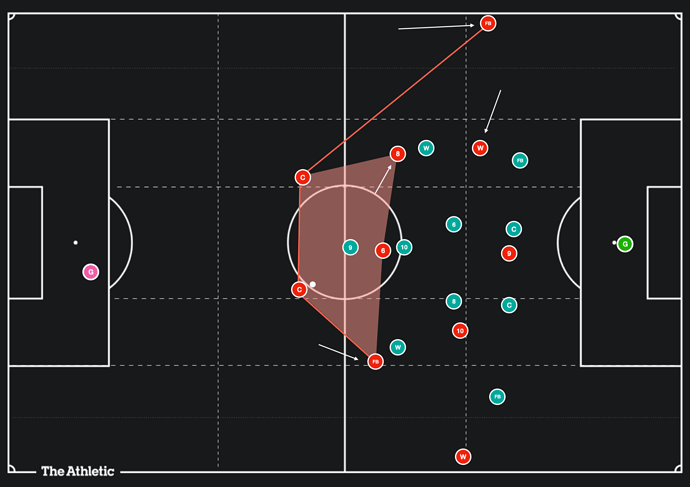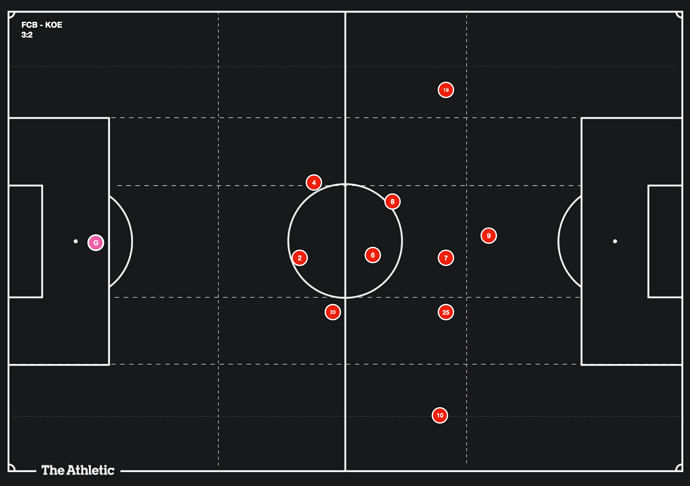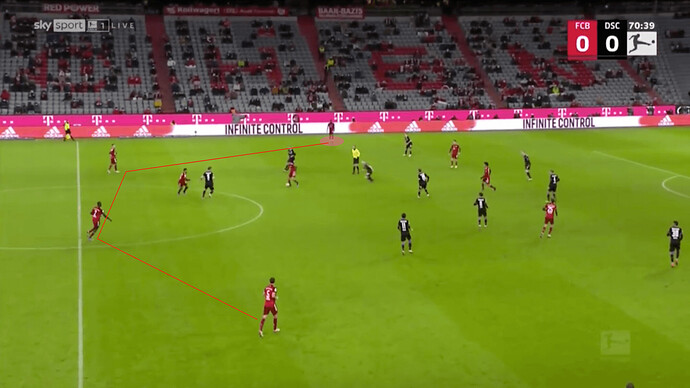Bin der Auffassung, dass er einen eigenen thread verdient. Letztendlich werden seine Philosophie, Prinzipien, Taktik, Auffassung zu Spielern und Spielertypen die nächsten Jahre prägen.
Hier beantwortet er viele aktuelle Fragen einiger Fans, was sicherlich kein one off sein dürfte. Top das er so etwas macht.
Überragend der Mann.
Weiß jetzt nicht ob es hier reinpasst, aber war die letzten Jahre wohl eher selten dass wir mehr als der Gegner laufen. Bin gespannt ob es nur die ersten Spieltage anhält oder ob wir unter Nagelsmann generell mehr laufen als der Gegner.
Guter Artikel von Honigstein Athletic
How Nagelsmann is fine-tuning Bayern goal machine: Fixing Sane, motivational ‘greed’ and differential learning
Midway through the first half against Dynamo Kyiv, the Allianz Arena twice cried out in heartfelt delight. The Bayern Munich crowd are notoriously spoilt by decades of success but the player who won their loudest approval on Wednesday night hadn’t done anything spectacular at all. Yet that was the point. Leroy Sane received rapturous applause for simply tracking back and dispossessing a Kyiv player off the ball twice in quick succession. Little more than a month ago, the 25-year-old had been jeered by sections of the stadium after another one of those ineffective, lifeless displays that put the wisdom of Bayern paying €60 million for him to [Manchester City] in question.
Right now, however, Sane is playing some of the best football of his career, combining regular decisive actions in the final third with an eagerness to put in the hard metres going the opposite direction. His transformation from mistrusted, insecure artist to hardworking crowd hero in the space of a mere few weeks has perhaps been the most eye-catching development since Julian Nagelsmann took charge of the still-unbeaten Bavarian goal machine (46 goals in 10 competitive games) this summer.
Fixing Leroy was near the top of Nagelsmann’s to-do list in Munich but even the 34-year-old might be surprised by how quickly the former Schalke 04 prodigy has found his feet. Bayern’s new manager hasn’t spoken quite as much to his players individually as his predecessor Hansi Flick did but he’s put extra time aside to boost Sane’s confidence. The two of them conducted special finishing sessions, and the Germany international was also encouraged to talk to the club sports psychologist. Nagelsmann carefully explained to the player that his pace was better used in gegenpressing pincer movements high up the pitch rather than making long runs on the wrong side of the ball into his own half.
Crucially, he’s also figured out that Sane, despite his own stated preference for playing as an inverted winger, was much better used on his natural side. On the left, the attacking prowess of full-back Alphonso Davies down the line has enabled Sane to be stationed further inside, as a second No 10 next to Thomas Muller, with plenty of freedom to take up productive positions in the box. Sources close to the club believe Flick’s readiness to use Sane in a similar way for the national team betrays a sense of regret that the coach hadn’t been able to come to this conclusion by himself during his time at Bayern.
As Sane shows, helping players perform is as much a case of collective/tactical direction as individual responsibility. Neither will function properly without the other. Nagelsmann has been in awe of the way the core group of leaders are setting the tone with their high intrinsic motivation in the dressing room and devised strategies to utilise that “greed”, as he calls it, in a systemic way on the pitch.
Bayern play a familiar high line but the gegenpressing impulse has worked much better than at the second half of Flick’s spell in Munich. In “Decoded”, a new analytics show with Ralf Rangnick on DAZN Germany, Nagelsmann revealed that Bayern had been the second-worst team of the [Bundesliga in conceding counter-attacks last season. On the whole, the German champions had shipped 44 league goals, their worst record in 40 years.
Things have changed. Bayern have kept five clean sheets in ten games, mainly because they have become far less vulnerable in defensive transitions. The pace of new signing Dayot Upamecano and a fully-fit Davies help in that regard, of course, but by winning the ball quicker, Bayern have markedly reduced the number of counter-attacks that materialise in the first place. Analysis from Lars Kornetka, a partner in Rangnick’s new footballing consultancy firm, shows that the average number of counter-attacks — defined as “starting in the opposition half and leading to a goal, a chance, a finish or a dangerous situation” — has dropped by a third, from 3.3 times per game on average under Flick to 2.2 under Nagelsmann.
“Winning the ball back in the opposition half is the strongest form of dominance there is,” the former RB football group coaching coordinator tells The Athletic. “You are constantly disrupting and demoralising the opposition. You are creating chances against an unsettled defence and you’re keeping the effect of randomness at a minimum: winning back the ball in the opposition half means fewer fouls in your own half, fewer set pieces to defend, fewer deflected shots that might creep in.”
Achieving this much control is subject to the player’s willingness to play with total intensity out of position but shouldn’t be confused with everyone running a lot. As Nagelsmann himself explained on the DAZN show in a lengthy tactics segment that made for mesmerising viewing, the key lies in the positioning of the players. They need to be both close enough to the ball to counter-press and staggered in a way that denies their opponents to bypass them easily through the centre.
Nagelsmann has, by and large, stuck to the 4-2-3-1 system of his predecessor but the actual shape in possession is rather different. One of the two full-backs will often move inside to build a block of three with Joshua Kimmich and Leon Goretzka in front of of the two centre-backs. The other full-back and the wide attacker on the opposite side push all way the forward as wingers, with the second wide forward lining up next to Muller as a “10” inside. The result looks like a 2-3-4-1, and makes it very hard for the opponents to press Bayern. They have plenty of options in the centre or can go wide early.
“I want to stretch the second line of the opponent, not the first one,” Nagelsmann explained about the width of his formation on the show, adding that the three central midfielders were able to shut down vertical balls through the middle and, at the same time, form what he calls a “second wave”, joining up in numbers to support the attack inside the opposition box.
That second wave has regularly crashed over opponents in devastating fashion, as Bayern have overwhelmed defences and increased the chance of loose balls falling to one of their own players. Before last week’s matches against Kyiv (5-0) and Furth (3-1), Kornetka calculated that Bayern had 4.4 players in the box on average for every goal scored. Two goals from open play, one each from transition and a longer spell of possession, were scored with seven players each in the box. (European Cup holders [Chelsea], by comparison, only averaged 2.8 players in the box per goal on average at that point of the season, Kornetka found.)
Other innovations are harder to quantify but surely add up. Players talk of a high-quality, variable training regime that constantly challenges them. Like Thomas Tuchel, Nagelsmann employs “differential learning” methods, setting his teams special tasks — a specific number of touches, direction of passes, or playing on differently-shaped pitches, for example — that render training exercises more stressful than the game itself.
Having noticed that Bayern had struggled with their throw-ins in the 7-0 win over Bochum, Nagelsmann’s coaching staff devised a special session in the following week. “You need solutions (for keeping the ball) because you’re one man down and teams use the throw-in as a pressing trigger,” he said. “But throw-ins also enable you to create good (attacking) situations, as opponents often push up and leave spaces at the other side of the pitch. That’s where the space is, that’s where we need to get to.”
On the whole, the emphasis is always on attacking football, on finding ways to speed up the game and to create space. Defensive behaviour, too, is being practiced as a subsection of Bayern’s offensive game, not in isolation; Nagelsmann told the squad that defensive stability starts in possession and stops with gegenpressing, or with the gegenpressing not working, to be precise. The watchwords are “active”, “connected”, “present”: he wants players to keep distances between the lines small and the width minimal after switching sides, to ensure that they can either get involved in the move or stop the opposition from attacking if it breaks down. In essence, his team are attacking and defending at the same time.
The net effect of all these small but decisive tweaks has been an all-round increase in performances from what were already very high levels last season, as the rolling xG for and against in the Bundesliga and [Champions League shows. Bayern are consistently above three expected goals in attack for the first time since the offensive peak of the Flick reign in winter 2019-20. Defensively, too, they’re back to the solidity off Flick’s first few months, with a downward trend approaching levels last seen under the much more cautious Niko Kovac.
Nagelsmann has undoubtedly benefited from factors beyond his control, such as the poor form of some of the teams he’s come up against domestically and in Europe (we’re looking at you, Hertha, Leipzig and Barcelona.) A fully-fit starting XI and support cast, coupled with the chance to rotate as the Bundesliga has continued the five-substitutions allowance, have kept fresh and players fully engaged. Pre-season doubts about the depth of the squad have only partially been allayed but, as long as the most important 14, 15 players are available and able to exercise Nagelsmann’s ideas as well as they have done, it’s hard to see them drawing too many games this season.
Raffa Honigstein ist sicherlich einer der kompetentsten und zugleich stilistisch elegantesten Sportjournalisten, und das gilt für seine Artikel auf Deutsch genauso wie für die auf Englisch. Hab auch seinen Bundesliga-Blog im Guardian immer sehr gemocht.
Absolut. Er gibt auch nicht einfach wieder was man bei decoded sehen kann, sondern nimmt den Hörer in die Hand, recherchiert, fragt nach und elaboriert weiter über die angesprochenen Themen.
Interview in der Times
Er kalkuliert Fehler / Ballverluste bewusst ein:
I always calculate that we could make a mistake but I want to have brave players on the pitch, try to solve the situation by having the ball, by trying to dribble. They should do some mistakes.
'That’s normal. But you have to have good structure behind the ball, then you can do some mistakes but they [opponents] didn’t counter much.
'If we see the space we try to speed up the game, have some kind of counter-attacks after your ball possession as well. And if you lose the ball, to be very, very aggressive in the counter-pressing. But if you have ball possession, it’s always about finding the good position behind the ball, very close distances between team-mates.
If you have the ball and you’re worse in counter-pressing, then you will get one counter-attack after another and you concede a lot of chances and the games will be very exhausting.’
Nagelsmann ist trotz Doppelimpfung positiv auf Corona getestet worden und geht jetzt erstmal in Quarantäne.
Nicht so gut. Ein Spiel ohne Cheftrainer o.k, aber jetzt wird er erstmal eine Zeitlang keinen persönlichen Kontakt zur Mannschaft halten können.
Ja das ist sehr ärgerlich.
Besonders in Gladbach wird er fehlen.
trotz „vollständiger Impfung“. Viele Sportler haben J&J gewählt, wie es bei Nagelsmann aussieht wissen wir nicht.
Da hast du natürlich recht.
Man weiß auch nicht, wann er geimpft wurde und was da an Schutz noch übrig ist.
["In letzter Zeit nicht einfach": Lewandowski provoziert Bayern-Zoff - n-tv.de]
Lewy nicht ganz zufrieden mit seiner aktuellen Rolle. Auffällig ist schon, dass er in den letzten Spielen nicht mehr so auffällig ist. Sprich, immer etwas schwer ins Spiel kommt.
Auch wenn es hier und da noch Anpassungen und Verbesserungen geben muss.
Nagelsmann hat unabhängig davon offensichtlich die Spieler hinter sich. Mit das wichtigste bei einem neuen Trainer.
Müller über Julian Nagelsmann
„Der Trainer ist der wichtigste Mann im Verein. Egal ob es gut oder schlecht läuft, ein Trainer kann die Mannschaft, die Spieler und sich selbst verändern. Er ist dafür verantwortlich, was auf dem Platz passiert und muss Strukturen schaffen, um Verantwortungen nach unten weiterzugeben. Wir können absolut zufrieden sein, wie es bisher mit Julian im ersten halben Jahr gelaufen ist. Wir stellen (Tor-)Rekorde auf und er hatte keine Anlaufschwierigkeiten, obwohl wir namhafte Abgänge hatten, die den Verein aus dem Effeff kannten. Julian ist ein Mensch, der nach Erfolg strebt. Er hat das Skill-Set, das du als Trainer brauchst: Die Gegner analysieren und die Mannschaft vorbereiten zum Beispiel. Er ist ein guter Mensch, der gut mit uns umgeht. Das war alles in allem ein sehr gelungener Einstand."
https://fcbayern.com/de/news/2021/12/die-vier-besten-aussagen-von-thomas-mueller-aus-unserem-talk
Hier ein sehr ausführlicher Artikel im the Athletic zu Nagelsmann und seiner Philosophie
Bayern are a different beast under Nagelsmann – they are stronger and more flexible
By Jasmine Baba Jan 25, 2022![]() 41
41 ![]()
How do you improve a team that had won every piece of silverware possible? And who have won nine Bundesliga titles in a row?
Those were the types of questions posed to Julian Nagelsmann when he took over at Bayern Munich in July last year. Six months later, his Bayern team are six points clear at the top of the Bundesliga and have coasted through their Champions League group with six wins from six matches.
There aren’t many of those questions anymore. Bayern haven’t just improved on a team level under Nagelsmann, their more dynamic structure has helped the players improve on an individual level too.
Starting with their build-up play, Nagelsmann uses an asymmetric 4-2-3-1 shape, pushing the left-back higher up the pitch. However, the remaining defensive players organise themselves in what looks like a back three, with the left-sided centre-back occupying the half-space, the right centre-back in the central area and the right-back in the right-sided half-space. (More on what makes the half-spaces special here.) Depending on the pressing style of their opponent, the right-back stays on the same level as both centre-backs or even pushes forward next to Bayern’s pivot players in midfield.
A small detail like the space of the right-sided full-back allows Nagelsmann to dynamically change his team’s build-up play from a 3+2 defensive structure into a 2+3, with that right-sided full-back joining the pivot players to make the three. This is problematic for the opposition while they try to press Bayern.
In addition to the space occupied by Bayern’s back four, different players change their role and positioning to fit into Nagelsmann’s system. With their left-back pushing forward, their left-sided winger can cut inside and occupy the half-space to attack the depth and space behind the defensive line or help Bayern progress the ball.
Depending on the role and positioning of Bayern’s right-sided full-back, the pivot players are either central in the 3+2 structure or shifted to the left in the 2+3, as shown below.
In the example above, Bayern’s left-sided pivot (No 8) is occupying the half-space in front of the opposition centre-back, and Bayern’s right-sided pivot (No 6) has moved into the central lane to allow the right-back (FB) to move forward. This creates multiple passing angles for the Bayern centre-back in possession, which allows smooth ball progression and circulation. Bayern’s centre-backs also have diagonal passing options into the wing zones and the team is well protected against counter-attacks.
By creating these rotational patterns, Nagelsmann allows his team to push a lot of attacking players forward into the final third and more specifically, the penalty area, which translates into their high chance creation and the outcome of goals. Bayern have 65 goals in 20 Bundesliga games this season under Nagelsmann, 13 more than their nearest challengers Dortmund.
The pitch map below shows the Bayern team’s average positions in the win against Koln earlier this season, using data from AWS. You can see how high Alphonso Davies, the left-back (No 19), was playing on the left, allowing Serge Gnabry (No 7) to drift inside. On the opposite flank, the right-back Tanguy Nianzou (No 23) tucked inside, with Leroy Sane (No 10) responsible for providing the width down that side.
It is clear which players have benefited from Nagelsmann’s set-up. Some who appeared to have plateaued have improved to a world-class level.
Davies’ role under Nagelsmann utilises his attacking threat by freeing the wing just for him. With his speed and agility, he doesn’t only provide width but now also attacks the depth and aids the team with his crossing, wing breakthroughs and chance creation. He technically acts like a wing-back but unlike Union Berlin’s use of them, he is not a goalscoring option. The Canada international also still defends as a full-back in a back four.
Bayern’s asymmetric build-up play with Davies pushing higher up the pitch on the left-hand side
Benjamin Pavard is the complete opposite of Davies in terms of his role in this team. He is the inverted full-back (No 5 above) in the 3+2 or 2+3 structure mentioned earlier. Having begun his career as a centre-back, Pavard has a skill set that is more suited to the team progressing and circulating the ball instead of running up and down the right-hand side. He is technically gifted enough to play as a part of the back three or push forward into the pivot space, making his inverted full-back role under Nagelsmann perfect for him.
The pivot players split up into two different functions; one is the Joshua Kimmich profile, that of a playmaker who sits deeper and organises the build-up play from that position. The second role, which is filled by either Leon Goretzka or Corentin Tolisso, is more offensive-based, with that player selectively joining Bayern’s attack by arriving in the box for headers or second balls.
The final position that has been greatly improved by Nagelsmann is the left wing, which is now Sane’s domain. Sane’s had been misused on the right by the former manager Hansi Flick but now due to Bayern’s rotations, he can play in the left half-space, allowing him to receive passes in between the lines or attack the space behind the last defensive line.
This has been a gamechanger for Sane, connecting him to the rest of the team and improving his angles for creating chances with his left foot. The 26-year-old has already matched his league goals scored from last season (six) and has seven assists too. In the Champions League group stage, he scored five goals and provided four assists.
Restructuring Bayern seemed like an impossible task for Nagelsmann when he joined six months ago but, even while dealing with injuries and a COVID-19 outbreak, this team has evolved and become far more flexible.
They are strolling towards a 10th Bundesliga title in a row and the improvement under Nagelsmann will provide a stark warning to their rivals in Champions League.
Sports Illustrated: SO FUNKTIONIERT DER NAGELSMANN-FUSSBALL – WIR MACHEN DEN TAKTIK DEEP DIVE
Tobi Escher an der Analyse. 
Liest sich interessant.
Kopfballduelle sollen in der Defensive vermieden werden;
Vielleicht nehmen das die Spieler manchmal zu ernst? ![]()
[FC Bayern: Julian Nagelsmann fordert Regeländerung]
Da muss ich unserem Trainer leider deutlich widersprechen. Für mich eher eine Horrorvorstellung.
Wenn ich mir vorstelle, was „clevere“ Trainer und Mannschaften aus solchen Unterbrechungen machen würden.
Puh, nein danke.

